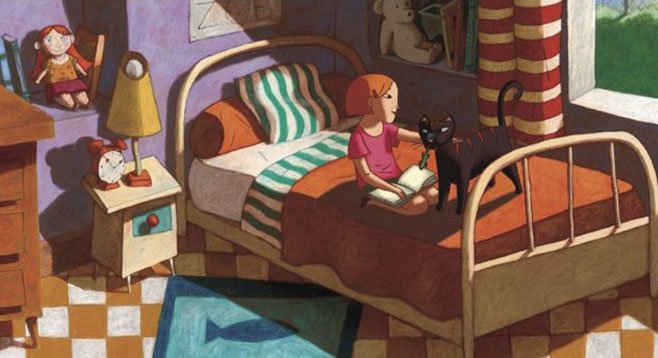 Facebook
Facebook
 X
X
 Instagram
Instagram
 TikTok
TikTok
 Youtube
Youtube

If they’d put as much love into the story as they did into the liquid, hand-colored look of things, this story of a sad little girl, a thief, and the cat who divides his time between the two would be a triumph. As it is, <em>A Cat in Paris </em>still deserves accolades for its use of the form -- the thief’s undulating grace, the pleasingly skewed perspectives in the Paris cityscapes, and a charmingly rendered rescue in Stygian darkness make for a visual feast. But oh, that story -- a conventional TV cop drama that wanders before devolving into an implausible action flick.
I don’t know if it’s a good thing or a bad thing that I always ask, “Why animate?” when I run into an animated feature. But good or bad, I do it. Jean-Loup Felicioli and Alain Gagnol’s A Cat in Paris offers several answers, some better than others.
The titular cat divides his time between a little girl named Zoé and Nico, a thief who prowls the rooftops and high walls of Paris like a parkour champion. (Or, um, like a cat.) The girl, meanwhile, has not spoken since her father was murdered by a gangster — a gangster who is planning to steal an African statue when it arrives in town. And who is the police superintendent in charge of stopping him (and also catching the cat burglar)? That’s right, Zoé’s mother. (Just like a cat to cozy up to both sides of the law; cats are notorious for this kind of slippery amorality.) It’s all very self-contained and tidy, which helps to explain the 70-minute run time.
So why animate this caper? Some promising early possibilities are Nico’s undulating fluidity as he slips along unnoticed on his nocturnal missions or the skewed perspective and hand-colored look of the pastel Paris cityscape. Even better later developments: Mom’s vision of her gangster nemesis as a scarlet octopus and a rescue carried out in utter darkness, the figures rendered as white lines on a black screen. Finally, in a Francophilic nod to Pepé Le Pew’s notorious tendrils of skunky stench, a whiff of pungent perfume plays a key role in the proceedings.
But in the end, the temptations inherent in drawing your own reality interfere with the story. What’s the point in being a super-agile parkour dude when an overweight, middle-aged gangster can match you jump for jump (and blow for blow) in the Big Final Chase? Toward the end I felt like I was watching a standard-issue action flick, except slower and more colorful. (And while I don’t know how much the medium influenced the message, the tone did slide here and there from taut drama to Looney Tunes banter.)
It was only after leaving that I thought of the most likely reason for going with a cartoon cat: a real one would have been impossible to train.


If they’d put as much love into the story as they did into the liquid, hand-colored look of things, this story of a sad little girl, a thief, and the cat who divides his time between the two would be a triumph. As it is, <em>A Cat in Paris </em>still deserves accolades for its use of the form -- the thief’s undulating grace, the pleasingly skewed perspectives in the Paris cityscapes, and a charmingly rendered rescue in Stygian darkness make for a visual feast. But oh, that story -- a conventional TV cop drama that wanders before devolving into an implausible action flick.
I don’t know if it’s a good thing or a bad thing that I always ask, “Why animate?” when I run into an animated feature. But good or bad, I do it. Jean-Loup Felicioli and Alain Gagnol’s A Cat in Paris offers several answers, some better than others.
The titular cat divides his time between a little girl named Zoé and Nico, a thief who prowls the rooftops and high walls of Paris like a parkour champion. (Or, um, like a cat.) The girl, meanwhile, has not spoken since her father was murdered by a gangster — a gangster who is planning to steal an African statue when it arrives in town. And who is the police superintendent in charge of stopping him (and also catching the cat burglar)? That’s right, Zoé’s mother. (Just like a cat to cozy up to both sides of the law; cats are notorious for this kind of slippery amorality.) It’s all very self-contained and tidy, which helps to explain the 70-minute run time.
So why animate this caper? Some promising early possibilities are Nico’s undulating fluidity as he slips along unnoticed on his nocturnal missions or the skewed perspective and hand-colored look of the pastel Paris cityscape. Even better later developments: Mom’s vision of her gangster nemesis as a scarlet octopus and a rescue carried out in utter darkness, the figures rendered as white lines on a black screen. Finally, in a Francophilic nod to Pepé Le Pew’s notorious tendrils of skunky stench, a whiff of pungent perfume plays a key role in the proceedings.
But in the end, the temptations inherent in drawing your own reality interfere with the story. What’s the point in being a super-agile parkour dude when an overweight, middle-aged gangster can match you jump for jump (and blow for blow) in the Big Final Chase? Toward the end I felt like I was watching a standard-issue action flick, except slower and more colorful. (And while I don’t know how much the medium influenced the message, the tone did slide here and there from taut drama to Looney Tunes banter.)
It was only after leaving that I thought of the most likely reason for going with a cartoon cat: a real one would have been impossible to train.
Comments